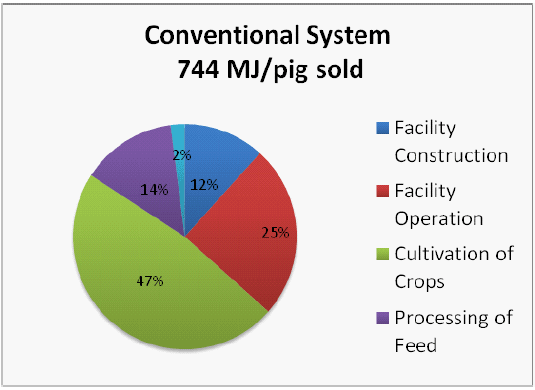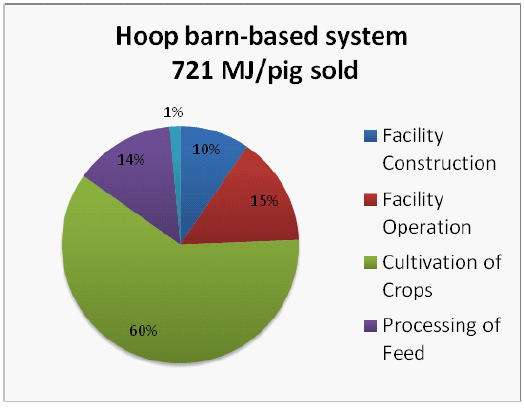



Energy Use and Nutrient Cycling in Pig Production Systems
Researchers explored all aspects of energy use in hog production from the perspective of two systems currently in use in Iowa – conventional confinement systems and bedded hoop barns, according to the Leopold Center for Sustainable Agriculture.How much energy does it take to raise a pig in different systems in Iowa?
This project answered the question by calculating direct and indirect energy flows into and through pig production systems based on physical material flows.
Background
Energy is used in all aspects of pig production, from the manufacture of materials for building construction to the cultivation and processing of feedstuffs. A pig production system includes pigs, buildings that house pigs, feed given to pigs and cropland used to grow the feed and as a site for recycling of manure nutrients. This project examined how energy is used by different types of pig production systems in Iowa.
A system for producing hogs consists of three elements: buildings used to house pigs, diets fed to the animals, and cropland used to produce the feedstuffs. The project examines non-solar energy use of different facility type × crop sequence × diet formulation strategies. Greenhouse gas emissions also are estimated based on non-solar energy use.
A corn-soybean crop sequence is commonly used throughout Iowa and corn-soybean meal diets are most commonly fed to pigs in the United States. This project also looked at several different crop sequences and diet strategies for pigs. Diverse crop rotations that include perennial forages have demonstrated environmental benefits, but those types of feedstuffs are not well utilised by pigs.
Approach and Methods
Process analysis methodology was used to calculate direct and indirect energy inputs into and through pig production systems based on physical material flows. A cradle-to-gate approach of Life Cycle Assessment that included embodied energy one step before the farm level was used. Consistent with process analysis methods, the investigators did not include solar energy and human labor inputs. Managing pigs in hoop barns requires a different set of skills and proficiencies compared to managing pigs in conventional systems, but labor is generally assumed to be similar for both types of housing systems.
Simplified design models of buildings used for each stage of pig production were generated and used to estimate building material use. The amount of pig spaces needed for a given level of production first was determined based on industry surveys and databases. Modeled building dimensions, layout and material choices were determined based on interviews with construction firms, facility managers and industry consultants.
Energy use for one 365-day period was modeled for each phase of pig production. The analysis includes energy used for thermal environment control (heating and ventilation), pumping water, cleaning facilities, and providing illumination, as well as feed consumption and bedding use as appropriate.
Different crop production scenarios, processes for preparing diet ingredients, and efficacy of various formulation strategies to minimize non-solar energy use and 100-yr global warming potential (GWP) from emissions associated with production of swine feed were detailed and examined. A crop production model for Iowa was developed and used to evaluate three types of non-solar energy inputs: diesel fuel, liquefied petroleum gas and electricity. A final summary analysis considered different combinations of facility type, crop sequence and diet formulation strategy.
Results and Discussion
Total energy use is similar between Iowa pig production systems, but the two types of buildings use energy differently. For example, the conventional barns use 15 per cent more energy for heating and ventilating, while a system that uses hoop barns for gestation and grow-finish pigs requires more feed and thus more energy for growing crops. Regardless of housing system, growing and processing pig feed is the largest single use of energy in pig production. Most of the energy used to produce pig feed is consumed during the production of synthetic nitrogen fertilizers.
Thus, management of nitrogen is essential for minimising energy use in Iowa pig production. The conventional pig production system stores liquid manure in deep pits and is very effective in returning nutrients in pig manure back to cropland. In hoop barns manure is handled as a solid, with manure, urine and bedding being mixed and composted inside the barn. While composting reduces the volume of material to be removed from the barn, it also can result in greater nitrogen losses.
In this analysis, Iowa pig production systems require 720 to 744MJ of energy per 270-lb market pig sold, or the energy equivalent of about six gallons of gasoline. This represents a reduction of nearly 85 per cent in energy use for pig production from 1975 – the last time energy use in Iowa pig production was examined – and compares favourably with European systems.
Conclusions
This analysis yielded three major differences between the conventional and hoop barn-based systems:
- non-solar energy necessary to operate buildings on a daily basis
- amount of feed required by pigs housed in the different facility types and
- amount of nitrogen retained in manure and ultimately delivered to cropland in the two systems.
The hoop barn-based system has a clear advantage in terms of energy used for building operation. Research has reported that raising pigs in hoop barns requires approximately three per cent more feed than conventional facilities. It should be noted that the genetic lines used in those studies have been developed for optimal performance in the conventional confinement facility. The fact that performance between the two housing systems was similar points to the adaptability of the pig. It is possible that through genetic selection and refinement of husbandry practices, the feed consumption by pigs housed in bedded hoop barns may be equal to or less than feed consumption in conventional systems.
The project analysis assumes that more nitrogen is lost from the bedding pack in a hoop barn than from the deep-pit of a conventional swine facility. However, there are multiple strategies that remain to be explored for reduced nitrogen loss from bedding packs. Hoop barns for pigs are relatively new options for producers. Although the conventional system did not develop within a vacuum, as farmers strive for optimal allocation of non-solar energy reserves and reduction of the global warming potential of pig production, support for alternative systems such as hoop barns is warranted, particularly in the area of bedding pack management.


Impact of Results
This project quantified energy use in the construction and operation of different types of modern pig production systems in Iowa. In general, producing pigs in Iowa in 2009 required nearly 85 per cent less non-renewable energy compared to 1975, when the last assessment was conducted.
This project also highlights critical differences between the types of energy used by different pig production systems. For example, while all pig production systems rely predominately on the energy found in feedstuffs, a conventional pig production system also requires large amounts of fossil fuel simply to operate the buildings. This contrasts with a hoop barn setup which uses slightly more feed, but considerably less fossil fuel to heat and ventilate the barns. This is important information for the discussion of energy use in agriculture.
The long-term impact of this analysis has yet to be realised, but the investigation provided essential background material for further examination of specific strategies aimed at reducing non-solar energy use and 100-year GWP of pig production systems.
Education and Outreach
This project generated one doctoral dissertation, three peer-reviewed publications, and one manuscript under review for publication. The journal publications were:
Lammers, P.J., M.S. Honeyman, J.D. Harmon, J.B. Kliebenstein and M.J. Helmers. 2009. Construction resource use of two different types and scales of Iowa swine production facilities. Applied Engineering in Agriculture 25: 585–593.
Lammers, P.J., M.S. Honeyman, J.D. Harmon, J.B. Kliebenstein and M.J. Helmers. 2010. Energy and carbon inventory of swine production facilities. Agricultural Systems 103:551–561. Appendix 2
Lammers, P.J., M.D. Kenealy, J.B. Kliebenstein, J.D. Harmon, M.J. Helmers and M.S. Honeyman. 2010. Non-solar energy use and 100-yr global warming potential of Iowa swine feedstuffs and feeding strategies. Journal of Animal Science 88:1204–1212.
Portions of this work have been presented to groups of producers through Iowa State University Extension and Outreach programs as well as at meetings of Practical Farmers of Iowa and the Land Stewardship Project of Minnesota. The key findings of this research and the associated publications also were shared with producer groups in Ukraine and Mongolia.
Leveraged funds
Nearly $10,000 in additional support was received through a graduate student research grant from the North Central Regional Sustainable Agriculture Research and Education (SARE) programme.
January 2012








